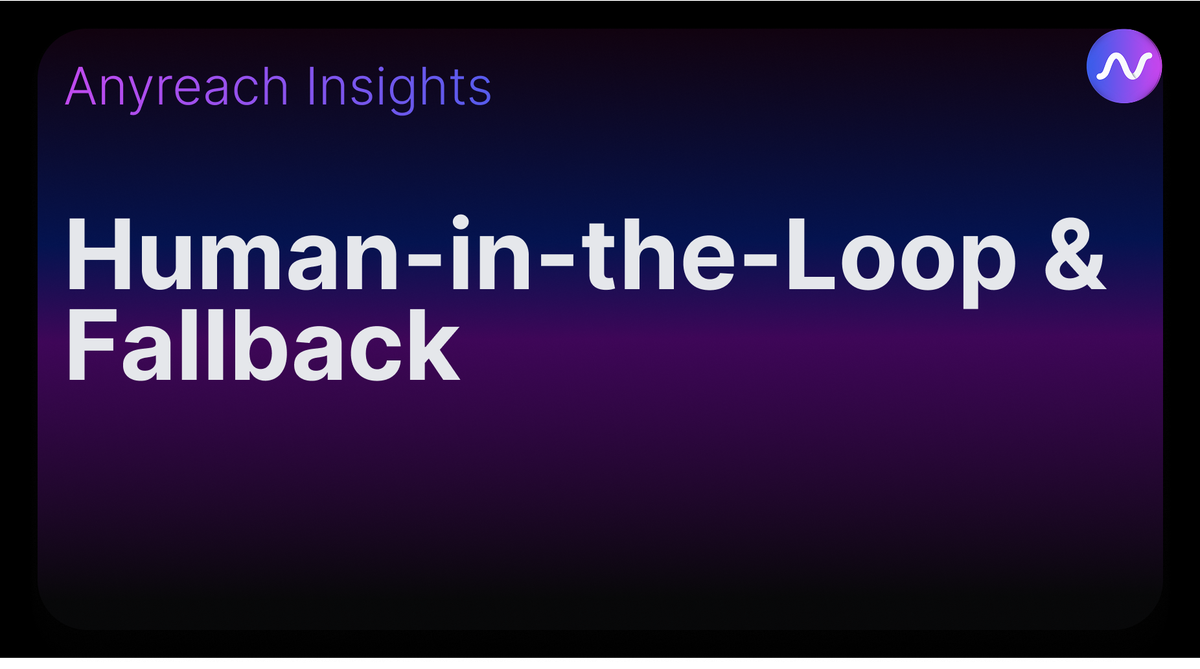What is Human-in-the-Loop in Agentic AI? A Complete Enterprise Guide

As enterprises accelerate their adoption of agentic AI—with 72-78% of organizations implementing AI solutions by 2024—a critical question emerges: How can businesses harness the efficiency of autonomous AI agents while maintaining the accuracy and reliability their operations demand? The answer lies in human-in-the-loop (HITL) systems and sophisticated fallback mechanisms that create a safety net for AI operations.
This comprehensive guide explores how mid-to-large BPOs and service-oriented companies are building trust in AI systems through strategic human oversight, addressing the primary concern that keeps 71% of enterprises from fully autonomous deployments: ensuring accuracy when AI faces uncertainty.
What is Human-in-the-Loop in Agentic AI?
Human-in-the-loop (HITL) in agentic AI refers to systems where human oversight, intervention, or collaboration is integrated into autonomous AI agent operations. This approach ensures accuracy during critical decision points, handles edge cases, and maintains reliability when AI confidence is low or hallucinations might occur.
Unlike traditional automation that follows rigid rules, agentic AI systems with HITL capabilities dynamically determine when human expertise is needed. This creates a collaborative intelligence model where AI handles routine tasks efficiently while humans provide judgment, creativity, and verification for complex scenarios.
According to recent industry research, only 29% of enterprises feel comfortable with fully autonomous AI agents, making HITL a critical bridge between current capabilities and future aspirations. This approach has proven particularly valuable in high-stakes domains like healthcare administration, financial services, and customer support, where accuracy isn't just preferred—it's mandatory.
Key Components of HITL Systems
- Confidence Thresholds: AI systems evaluate their own certainty levels and request human input when below defined thresholds
- Escalation Triggers: Predefined scenarios that automatically route to human experts (e.g., customer frustration, compliance issues)
- Collaborative Workflows: Structured processes where AI and humans work together on complex tasks
- Feedback Loops: Mechanisms for humans to correct AI outputs and improve future performance
How Does Fallback Handle Hallucinations in BPOs?
Fallback mechanisms in BPOs handle AI hallucinations through multiple strategies: asking for clarification when uncertain, flagging low-confidence responses, cross-checking against source databases, and seamlessly transferring to human agents when confidence thresholds aren't met. This ensures accuracy while maintaining operational efficiency.
The challenge of AI hallucinations—where models generate plausible but incorrect information with high confidence—represents one of the most significant barriers to enterprise AI adoption. A 2025 study found that 38.9% of organizations cite accuracy concerns as their top AI challenge, making robust fallback mechanisms essential for maintaining trust.
Proven Fallback Strategies for BPOs
| Strategy | Implementation | Success Metric |
|---|---|---|
| Retrieval-Augmented Generation (RAG) | Grounds responses in real-time verified data | 65% reduction in fabricated responses |
| Multi-Agent Validation | Multiple AI agents cross-check each other's outputs | 40% improvement in accuracy |
| Confidence Scoring | AI rates its own certainty and flags low scores | 71% of errors caught pre-delivery |
| Source Attribution | AI cites specific sources for verification | 85% increase in trust ratings |
Klarna's implementation demonstrates the power of well-designed fallback systems. Their AI agent successfully automated 65% of customer support interactions while reducing average handling time by 66%. The key? A sophisticated handoff protocol that ensures smooth transitions when the AI encounters scenarios beyond its training.
Real-World Implementation Example
Consider a telecommunications BPO handling technical support. When a customer describes an unusual network issue, the AI agent:
- Searches its knowledge base for similar cases
- Evaluates confidence in proposed solutions (typically 0-100 scale)
- If confidence falls below 80%, it either:
- Asks clarifying questions to gather more information
- Suggests preliminary troubleshooting while flagging for human review
- Initiates seamless transfer with full context summary
- Documents the interaction for continuous improvement
What Ensures Seamless Transfer in AI Takeover for High Accuracy?
Seamless transfer during AI-to-human handoffs is ensured through complete context summaries, documented handoff protocols, integrated communication systems, and real-time dashboards. These mechanisms prevent customers from repeating information while maintaining conversation continuity and accuracy standards.
The quality of AI-to-human handoffs directly impacts customer satisfaction and operational efficiency. Research shows that poorly executed transfers can negate the efficiency gains of AI automation, making seamless handoff capabilities a critical differentiator for enterprise AI solutions.
Essential Elements of Seamless Transfer
1. Context Preservation
- Complete conversation history with AI analysis
- Customer sentiment indicators and frustration levels
- Attempted solutions and their outcomes
- Relevant customer data and preferences
2. Intelligent Routing
- Skill-based assignment to appropriate human agents
- Priority queuing based on issue severity
- Load balancing across available resources
- Time-zone aware scheduling for follow-ups
3. Communication Continuity
- Unified interface showing AI interactions
- Highlighted key information for quick agent orientation
- Suggested next actions based on AI analysis
- Seamless channel switching (chat to voice, etc.)
Building Trust Through Reliability: Industry-Specific Applications
Healthcare Administration: Where Accuracy is Non-Negotiable
Healthcare organizations implement HITL with exceptional rigor due to regulatory requirements and patient safety concerns. A typical implementation includes:
- Mandatory Expert Review: All AI-generated recommendations undergo human verification before implementation
- Cross-Reference Validation: AI outputs are automatically checked against medical databases like PubMed
- Audit Trail Maintenance: Complete documentation of AI decisions and human interventions for compliance
- Gradual Autonomy: Starting with low-risk administrative tasks before expanding to clinical support
Education and E-Learning: Balancing Efficiency with Pedagogical Effectiveness
Educational institutions leverage HITL to ensure AI-generated content meets pedagogical standards while scaling personalized learning:
- Content Validation: Subject matter experts review AI-generated educational materials
- Student Interaction Monitoring: Human educators oversee AI tutoring sessions for quality
- Adaptive Intervention: Automatic escalation when students show signs of confusion or frustration
- Continuous Refinement: Educators provide feedback to improve AI responses
Consulting and Professional Services: Maintaining Expertise Standards
Consulting firms implement HITL to ensure AI-augmented services maintain their reputation for expertise:
- Collaborative Analysis: AI performs initial data analysis with consultants providing interpretation
- Quality Checkpoints: Defined stages where human experts validate AI recommendations
- Client-Facing Safeguards: All AI-generated client communications reviewed before delivery
- Knowledge Capture: Human insights fed back to improve AI models
Implementation Best Practices: A Roadmap for Success
Phase 1: Foundation Building (Weeks 1-4)
- Assess Current State
- Document existing workflows and pain points
- Identify high-value automation opportunities
- Evaluate technical infrastructure readiness
- Define Success Metrics
- Establish baseline performance indicators
- Set realistic automation targets (typically 40-65% for initial deployment)
- Create accuracy and satisfaction thresholds
Phase 2: Pilot Implementation (Weeks 5-12)
- Start with Internal Processes
- 33.7% of enterprises prefer beginning with internal use cases
- Lower risk allows for learning and refinement
- Builds organizational confidence in AI capabilities
- Design Handoff Protocols
- Map specific triggers for human intervention
- Create context transfer templates
- Establish escalation hierarchies
Phase 3: Scaled Deployment (Weeks 13-24)
- Gradual Customer-Facing Rollout
- Begin with low-complexity, high-volume interactions
- Monitor performance metrics in real-time
- Adjust confidence thresholds based on outcomes
- Continuous Optimization
- Regular review of handoff effectiveness
- Feedback integration from human agents
- Model retraining based on edge cases
Measuring Success: KPIs That Matter
| Metric | Target Range | Measurement Method | Business Impact |
|---|---|---|---|
| First Contact Resolution | 25-40% improvement | Pre/post implementation comparison | Reduced operational costs |
| Average Handling Time | 50-66% reduction | Time tracking systems | Increased agent productivity |
| Customer Satisfaction | Maintain or improve | CSAT surveys | Brand reputation protection |
| Escalation Rate | 20-35% of interactions | Handoff tracking | Balance of efficiency and accuracy |
| Accuracy Rate | >95% for automated responses | Quality assurance sampling | Trust and reliability |
Overcoming Common Challenges
Challenge 1: Resistance to AI Adoption
Solution: Emphasize AI as an augmentation tool, not replacement. Show how HITL systems enhance human capabilities rather than diminish them. Provide comprehensive training that builds confidence in working alongside AI.
Challenge 2: Integration Complexity
Solution: Start with API-based integrations that don't require deep system changes. Use middleware platforms that can bridge legacy systems with modern AI capabilities. Plan for phased integration rather than wholesale replacement.
Challenge 3: Maintaining Consistency
Solution: Develop detailed playbooks for common scenarios. Use AI to suggest standardized responses while allowing human customization. Regular calibration sessions ensure alignment between AI and human approaches.
Challenge 4: Cost Justification
Solution: Focus on total value rather than just cost reduction. Include metrics like employee satisfaction, reduced errors, and improved compliance in ROI calculations. Document both hard and soft benefits.
Future-Proofing Your HITL Strategy
As AI capabilities continue to evolve, successful enterprises are building flexible HITL frameworks that can adapt to changing technology and business needs:
Emerging Trends to Watch
- Predictive Handoffs: AI systems that anticipate the need for human intervention before issues arise
- Collaborative Learning: Real-time model updates based on human corrections
- Emotion-Aware Transfers: Advanced sentiment analysis triggering proactive human engagement
- Multi-Modal Integration: Seamless handoffs across voice, chat, video, and email channels
Building Adaptive Capabilities
- Modular Architecture: Design systems that can incorporate new AI models without complete overhauls
- Continuous Learning Culture: Regular training updates for both AI systems and human teams
- Feedback Loop Optimization: Automated capture and integration of improvement opportunities
- Scalability Planning: Infrastructure that can handle increasing automation percentages over time
Frequently Asked Questions
How quickly can enterprises expect to see ROI from HITL implementations?
Most enterprises report initial efficiency gains within 3-6 months, with full ROI realization typically occurring within 12-18 months. Early wins often come from reduced handling times and improved first contact resolution rates.
What training do human agents need for effective AI collaboration?
Successful programs include AI literacy basics, interpretation of AI-provided data, recognition of intervention triggers, and skills for personalizing interactions post-handoff. Training typically requires 20-40 hours initially with ongoing refreshers.
How do you determine the right automation percentage for your organization?
Start by analyzing interaction complexity and risk levels. High-volume, low-complexity tasks might achieve 70-80% automation, while complex, high-stakes interactions might target 30-40%. The key is gradual increase based on performance data.
What are the most common mistakes in HITL implementation?
Common pitfalls include over-automating too quickly, inadequate handoff protocols, insufficient agent training, and neglecting to gather feedback for continuous improvement. Success requires patience and iterative refinement.
How do you maintain quality when scaling HITL systems?
Implement robust quality assurance processes including regular audits, mystery shopping, sentiment analysis, and performance dashboards. Maintain a feedback loop between quality findings and system improvements.
Conclusion: The Path to Reliable AI
Human-in-the-loop systems represent more than a temporary bridge to fully autonomous AI—they embody a fundamental shift in how enterprises approach intelligent automation. By acknowledging both the tremendous potential and current limitations of AI, organizations can build systems that deliver efficiency without sacrificing accuracy or trust.
The evidence is clear: enterprises that thoughtfully implement HITL mechanisms achieve remarkable results. From Klarna's 66% reduction in handling time to healthcare organizations maintaining compliance while scaling operations, the combination of AI efficiency and human judgment creates value that neither could achieve alone.
As your organization embarks on or expands its agentic AI journey, remember that success lies not in choosing between human or artificial intelligence, but in orchestrating their collaboration. The future belongs to enterprises that master this balance, creating seamless experiences that leverage the best of both worlds.
The question isn't whether to implement human-in-the-loop systems—it's how quickly you can build the reliable, scalable, and trustworthy AI operations your business needs to thrive in an increasingly automated world.


![[AI Digest] Orchestration Stability Multimodal Research Advances](/content/images/size/w600/2025/07/Daily-AI-Digest.png)